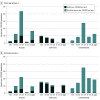Epidemiologic Trends in Fatal and Nonfatal Firearm Injuries in the US, 2009-2017
- PMID: 33284327
- PMCID: PMC7851729
- DOI: 10.1001/jamainternmed.2020.6696
Epidemiologic Trends in Fatal and Nonfatal Firearm Injuries in the US, 2009-2017
Abstract
Importance: Firearm injury research in the US has focused on fatal injuries. The incidence and epidemiologic factors associated with nonfatal firearm injuries are less understood.
Objective: To evaluate estimates of incidence and trends over time of fatal and nonfatal firearm injuries.
Design, setting, and participants: A cross-sectional, ecologic study was conducted using data throughout the US from 2009 to 2017. Data on fatal injuries from the Centers for Disease Control and Prevention were combined with national data on emergency department visits for nonfatal firearm injury from the Nationwide Emergency Department (ED) sample. Data analysis was conducted from August 2019 to September 2020.
Exposures: Firearm injuries identified with International Classification of Diseases external cause of injury codes and categorized by intent of injury, age group, and urban-rural location.
Main outcomes and measures: Incidence, case fatality rate, and trends over time of firearm injury according to intent, age group, and urban-rural location.
Results: From 2009 to 2017, there was a mean of 85 694 ED visits for nonfatal firearm injury and 34 538 deaths each year. An annual mean of 26 445 deaths (76.6%) occurred outside of the hospital. Assault was the most common overall mechanism (38.9%), followed by unintentional injuries (36.9%) and intentional self-harm (19.6%). Self-harm, which accounted for 21 128 deaths (61.2%), had the highest case fatality rate (89.4%; 95% CI, 88.5%-90.4%), followed by assault (25.9%; 95% CI, 23.7%-28.6%) and legal intervention (23.4%; 95% CI, 21.6%-25.5%). Unintentional injuries were the most common nonfatal injuries (43 729 [51.0%]) and had the lowest case fatality rate (1.2%; 95% CI, 1.1%-1.3%). Self-harm deaths, 87.8% of which occurred outside the hospital, increased in all age groups in both rural and urban areas during the study period and were most common among people aged 55 years and older. The rate of fatal assault injuries was higher in urban than in rural areas (16.6 vs 9.0 per 100 000 per year) and highest among people aged 15 to 34 years (38.6 per 100 000 per year). Rates of unintentional injury were higher in rural than in urban areas (18.5 per 100 000 vs 12.4 per 100 000).
Conclusions and relevance: In this cross-sectional study, suicide appears to be the most common cause of firearm injury death in the US, and most people who die from suicide never reach the hospital. These findings suggest that assaults and unintentional injuries account for most nonfatal and overall firearm injuries and for most of the injuries that are treated in hospitals.
Conflict of interest statement
Figures
Comment in
-
The Problem With ICD-Coded Firearm Injuries.JAMA Intern Med. 2021 Aug 1;181(8):1132-1133. doi: 10.1001/jamainternmed.2021.0382. JAMA Intern Med. 2021. PMID: 33779677 No abstract available.
-
The Problem With ICD-Coded Firearm Injuries-Reply.JAMA Intern Med. 2021 Aug 1;181(8):1133-1134. doi: 10.1001/jamainternmed.2021.0385. JAMA Intern Med. 2021. PMID: 33779696 No abstract available.
References
-
- Bulger EM, Stewart RM A public health approach reduced deaths from car crashes: it can do the same for gun violence. Los Angeles Times Published September 13, 2019. Accessed September 16, 2019. https://www.latimes.com/opinion/story/2019-09-13/public-health-approach-...
Publication types
MeSH terms
LinkOut - more resources
Full Text Sources
Other Literature Sources



